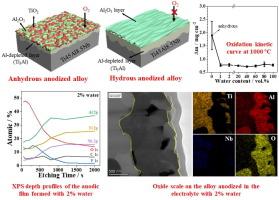揭示了电解液中含水量对阳极氧化Ti45Al8.5Nb合金微观组织和氧化性能的影响
IF 6.9
2区 材料科学
Q2 CHEMISTRY, PHYSICAL
引用次数: 0
摘要
TiAl合金由于其轻质和优异的机械性能而成为高温应用的有前途的材料,但其抗氧化性在700°C以上显着恶化。氟电解液阳极氧化已成为解决这一挑战的有效策略。本研究系统地研究了NH4F/乙二醇电解液中含水量对阳极氧化Ti45Al8.5Nb合金微观结构和氧化性能的影响。结果表明,水含量对氧源和氟在阳极膜中的富集有重要影响。在无水电解质中进行阳极氧化,由于有机成分从阳极膜中挥发,并且阳极膜/衬底界面处的氧分压升高,导致形成一种混合松散的氧化垢。相反,引入2 %的水促进了紧凑的氧化铝基氧化垢的发展。在1000 ℃下氧化100 h后,在最佳含水量电解液中阳极氧化的Ti45Al8.5Nb合金的增重量小于在无水电解液中阳极氧化样品的一半。本文章由计算机程序翻译,如有差异,请以英文原文为准。


Unraveling the effect of water content in the electrolyte on the microstructure and oxidation performance of anodized Ti45Al8.5Nb alloy
TiAl alloys are promising materials for high-temperature applications due to their lightweight and superior mechanical properties, but their oxidation resistance significantly deteriorates above 700°C. Anodization in fluorine electrolyte has emerged as an effective strategy to address this challenge. In this study, we systematically investigated the role of water content in NH4F/ethylene glycol electrolyte on the microstructure and oxidation performance of anodized Ti45Al8.5Nb alloy. Results revealed that water content critically influences the oxygen source and fluoride enrichment in the anodic film. Anodization in anhydrous electrolyte results in the formation of a mixture loose oxide scale due to the volatilization of organic component from the anodic film and elevated oxygen partial pressure at the anodic film/substrate interface. In contrast, introducing 2% water promotes the development of a compact Al2O3-based oxide scale. After 100 h oxidation at 1000 °C, the weight gain of Ti45Al8.5Nb alloy anodized in the electrolyte with optimal water content was less than half of the sample anodized in anhydrous electrolyte.
求助全文
通过发布文献求助,成功后即可免费获取论文全文。
去求助
来源期刊

Applied Surface Science
工程技术-材料科学:膜
CiteScore
12.50
自引率
7.50%
发文量
3393
审稿时长
67 days
期刊介绍:
Applied Surface Science covers topics contributing to a better understanding of surfaces, interfaces, nanostructures and their applications. The journal is concerned with scientific research on the atomic and molecular level of material properties determined with specific surface analytical techniques and/or computational methods, as well as the processing of such structures.
 求助内容:
求助内容: 应助结果提醒方式:
应助结果提醒方式:


